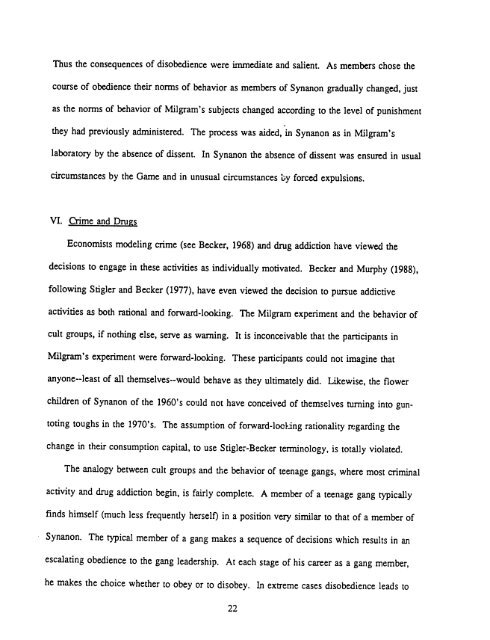INSTITUTE FOR
INSTITUTE FOR
INSTITUTE FOR
You also want an ePaper? Increase the reach of your titles
YUMPU automatically turns print PDFs into web optimized ePapers that Google loves.
Thus the consequences of disobedience were immediate and salient. As members chose the<br />
course of obedience their norms of behavior as members of Synanon gradually changed, just<br />
as the norms of behavior of Milgram's subjects changed according to the level of punishment<br />
they had previously administered. The process was aided, in Synanon as in Milgram's<br />
laboratory by the absence of dissent. In Synanon the absence of dissent was ensured in usual<br />
circumstances by the Game and in unusual circumstances by forced expulsions.<br />
VI. Crime and Drugs<br />
Economists modeling crime (see Becker, 1968) and drug addiction have viewed the<br />
decisions to engage in these activities as individually motivated. Becker and Murphy (1988),<br />
following Stigler and Becker (1977), have even viewed the decision to pursue addictive<br />
activities as both rational and forward-looking. The Milgram experiment and the behavior of<br />
cult groups, if nothing else, serve as warning. It is inconceivable that the participants in<br />
Milgram's experiment were forward-looking. These participants could not imagine that<br />
anyone--least of all themselves--would behave as they ultimately did. Likewise, the flower<br />
children of Synanon of the 1960's could not have conceived of themselves turning into guntoting<br />
toughs in the 1970's. The assumption of forward-looking rationality r.garding the<br />
change in their consumption capital, to use Stigler-Becker terminology, is totally violated.<br />
The analogy between cult groups and the behavior of teenage gangs, where most criminal<br />
activity and drug addiction begin, is fairly complete. A member of a teenage gang typically<br />
finds himself (much less frequently herself) in a position very similar to that of a member of<br />
Synanon. The typical member of a gang makes a sequence of decisions which results in an<br />
escalating obedience to the gang leadership. At each stage of his career as a gang member,<br />
he makes the choice whether to obey or to disobey. In extreme cases disobedience leads to<br />
22

















